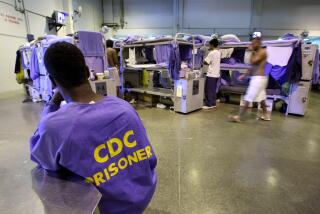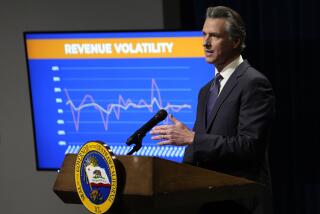Gov.’s budget plan: no deficit, more debt
- Share via
SACRAMENTO — Gov. Arnold Schwarzenegger released a $143.4-billion spending plan Wednesday that would wipe out the chronic multibillion-dollar deficits that have plagued the state since before he came to office while at the same time running up a new credit card bill for future Californians.
The budget, which was met with measured optimism across party lines, also proposes a dramatic policy shift -- eliminating parole supervision for thousands of nonviolent offenders. The move, sure to be controversial, would free up dollars needed to pay for the greater scrutiny of sex offenders mandated by voter-approved Proposition 83.
“I am proud to say in the budget our new operating deficit has been reduced to zero,” Schwarzenegger said at a Sacramento news conference. “We must continue our discipline. We cannot slip into the same old habits.”
But the budget blueprint includes $43.3 billion in new borrowing to pay for school, university, prison and courthouse construction projects, as well as levees and dams, raising concern in the Capitol and in some quarters of the financial community about burdening future generations with too much debt. The proposed borrowing comes after voters approved a public works bond package of nearly the same size only two months ago.
“The state is already on the razor’s edge in terms of fiscal balance,” said Ryan Ratcliff, an economist at the UCLA Anderson Forecast. “This would make things even more tenuous.”
The budget also includes revenue assumptions that Republican lawmakers warned may be overly rosy.
As the governor forges ahead with his ambitious public works plans, and a proposal being watched nationwide to create universal healthcare in California, most of the major changes in his budget involve scaling back.
More than one Democrat described the document as a “mixed bag.”
“The governor needs to be commended and congratulated for making an effort to balance this budget in a way that’s fair and fiscally prudent,” said Assembly Speaker Fabian Nunez (D-Los Angeles), who like other Democrats was pleased by a boost in education spending. “At the same time, we do have some concerns.”
Chief among them is Schwarzenegger’s plan to cut the state’s welfare program, known as CalWORKS, by $465 million. The savings would be achieved largely by eliminating certain cash grants intended for children whose parents do not meet minimum work requirements or are illegal immigrants. Advocates for the poor say the grants are meant as a safety net to keep families from becoming homeless. Democrats, who control the Legislature, say the proposal is a nonstarter.
Transit officials vow fight
Schwarzenegger is also proposing to use a $1.1-billion windfall from the sales tax on gas -- the result of soaring prices at the pump last year -- to plug holes in the budget, instead of spending the money on public transit projects. Local transportation officials said they will fight to keep the money for their own agencies. Some Democrats have already joined them.
“This is bad news for bus and rail operations,” said Bart Reed, executive director of the Transit Coalition, a nonprofit organization based in Sylmar. “The governor is picking on those who can’t afford to fight back: the transit rider.”
Since 2000, Reed said, about $1.68 billion of the tax money has been diverted to other state programs, contributing to a deterioration of bus and commuter rail services.
At the Los Angeles County Metropolitan Transportation Authority, officials estimate that the proposed budget could cost the giant agency about $260 million, or about 8% of its annual transit budget. Some of that money, they said, is used to serve hundreds of thousands of students and disabled riders.
Administration officials argued that the transit agencies would not have their funding cut but merely be deprived of a windfall of new revenue.
One of the most provocative features of the budget focuses on the state’s floundering correctional system, beset by severe crowding and a reputation for doing little to prepare inmates for a crime-free life upon release.
Several years ago, a nonpartisan watchdog panel dubbed California’s parole system “a billion-dollar failure,” with two-thirds of ex-convicts returning to prison -- the worst such rate in the nation.
Following the lead of other states, Schwarzenegger wants to eliminate parole supervision for about 24,000 nonviolent offenders leaving prison each year. He also would give thousands more the chance to earn their way off parole with one year of “clean time” -- or no parole violations. Although that option is available now, parolees must petition for approval.
Under current law, virtually all ex-convicts are placed on parole for a minimum of three years. While under supervision, they must meet regularly with their agent, undergo drug testing and abide by numerous other restrictions.
California is one of only two states that subject all former prisoners to such a lengthy parole period, regardless of their crime. Administration officials say that in a world of finite resources, it makes more sense to focus parole scrutiny on the truly dangerous.
“This is smart policy and a dramatic change for California,” said UC Irvine criminologist Joan Petersilia. She said requiring ex-convicts to “earn” their way off parole with a year of clean time, in particular, makes sense and has shown good results elsewhere.
Corrections Secretary James Tilton said the no-parole policy would cover only those convicted of nonviolent crimes, including drug offenses, auto theft, forgery and fraud. Altogether, he said, the changes would save about $56.7 million next fiscal year and more than $75 million the following year.
Meanwhile, Tilton estimates that he will need $77 million next year -- and significantly more in following years -- for parole agents and global positioning satellite technology to monitor sex offenders under Proposition 83. The initiative, passed overwhelmingly by voters in November, requires sex offenders to be tracked electronically for life.
Conservator oversight
Another surprise in the budget is the inclusion of more than $17 million for increased court oversight of conservators, who manage the finances and healthcare decisions for the state’s most vulnerable residents. The money will help probate courts send investigators out more often to visit elderly or infirm people under conservatorship and gives courts the ability to audit the financial reports of conservators. A series published by The Times in 2005 described how some conservators neglected their wards, isolated them from relatives and ran up fees.
There are also items in the governor’s plan likely to appeal to the conservative wing of the Republican Party. In addition to the CalWORKS reductions, the budget would eliminate funding for the University of California’s labor and employment program, which has worked with unions in researching how to most effectively organize.
Nunez said the governor had assured him that the program, which is planned to be renamed after the late Los Angeles County labor chief Miguel Contreras next week, would not be cut.
“It’s safe to say this will be one of the first cuts that will be restored” in the Democrat-dominated legislative budget process, Nunez said.
The governor wipes out a deficit recently projected by the Legislature to be $5.5 billion by using unexpectedly high revenue estimates, early repayment of bond debt and spending restraint.
Skepticism over deficit
Not everyone was convinced that Schwarzenegger’s plan would erase the chronic deficit. The administration’s projections about the state of the economy and the amount of tax revenue that will be generated are considerably more optimistic than those reported late last year by nonpartisan Legislative Analyst Elizabeth G. Hill, whom lawmakers of both parties look to for guidance on budget matters.
Department of Finance Director Mike Genest said the administration had the benefit of updated data that were unavailable to Hill at the time she put together her report.
Fiscal conservatives were skeptical.
“My concern is that the new revenue numbers are overly optimistic,” said state Sen. George Runner (R-Lancaster), echoing the view of several lawmakers in his caucus.
Will funds materialize?
Others worried that some of the new funds the governor says will flow into state coffers because of his proposed policy changes will never materialize. The budget relies, for example, on the state’s securing $506 million as a result of new gambling compacts with Indian tribes. Those agreements have yet to be approved by the Legislature, and some fiscal experts doubt whether the new gambling venues would bring in that much money if they were permitted.
Schwarzenegger’s plan would also balance the books by dipping into the state’s fledgling rainy day fund. While other states have built reserves of 10% of their budget or more, California’s is less than 3% of the general fund, which pays for most of the basic services the state provides. Under the governor’s plan, the reserve would drop to about 2%.
But the criticism of the budget from GOP lawmakers was mild compared with what the governor endured earlier in the week, when he unveiled his proposals for healthcare and public works spending. Some lawmakers, however, used the budget unveiling as another opportunity to take a swipe at those plans.
“While I am pleased that the governor’s state budget proposal currently contains no tax increases,” said Assemblywoman Mimi Walters (R-Laguna Niguel), “I fear that ultimately the inclusion of his aggressive healthcare agenda will result in a greater tax burden for California taxpayers.”
*
Times staff writers Peter Nicholas, Jordan Rau, Jack Leonard, Joe Mathews and Dan Weikel contributed to this report.
*
Begin text of infobox
Give and take
Highlights of the governor’s 2007 budget proposal:
Winners
Public school funding: up hundreds of dollars per student
Environmentalists: $32 million for greenhouse gas reduction
Nonviolent offenders: freed of parole requirements
Farmers: $2 million more for programs to combat food-borne bacteria
Prisons: billions for new construction
Vocational education: $52 million to expand course offerings
Losers
Public transit: doesn’t get $1.1-billion windfall of gasoline sales tax revenue
Teachers: denied a $165-million tax credit
Poor children whose parents are here illegally or not meeting work requirements: state aid cut off
Yacht owners who dock in Mexico: lose tax loophole
*
Source: Times reporting
**
Revenue and spending plan
Here is how the governor’s 2007-08 budget proposal breaks down general fund revenues and expenditures:
Revenue sources:
Personal income tax - $55.6 Dollars (In billions), 54.9% Percent of total
Sales tax - 29.3 Dollars (In billions), 29.0% Percent of total
Corporation tax -10.8 Dollars (In billions), 10.7% Percent of total
Insurance tax - 2.4 Dollars (In billions), 2.3% Percent of total
Liquor tax - 0.3 Dollars (In billions), 0.3% Percent of total
Tobacco taxes - 0.1 Dollars (In billions), 0.1% Percent of total
Other - 2.7 Dollars (In billions), 2.7% Percent of total
Total$101.2
Expenditures:
K-12 education - $40.5 Dollars (In billions), 39.3% Percent of total
Health and human services - 29.9 Dollars (In billions), 29.0% Percent of total
Higher education - 12.0 Dollars (In billions), 11.6% Percent of total
Corrections and rehabilitation - 10.0 Dollars (In billions), 9.7% Percent of total
Legislative, judicial and executive - 3.8 Dollars (In billions), 3.7% Percent of total
General government - 3.1 Dollars (In billions), 3.0% Percent of total
Business, transportation and housing - 1.6 Dollars (In billions), 1.5% Percent of total
Resources - 1.5 Dollars (In billions), 1.4% Percent of total
State and consumer services - 0.6 Dollars (In billions), 0.6% Percent of total
Labor and work force development - 0.1 Dollars (In billions), 0.1% Percent of total
Environmental protection - 0.1 Dollars (In billions), 0.1% Percent of total
Total$103.2
Note: Numbers may not add up to total because of rounding
Source: Governor’s budget
More to Read
Get the L.A. Times Politics newsletter
Deeply reported insights into legislation, politics and policy from Sacramento, Washington and beyond. In your inbox twice per week.
You may occasionally receive promotional content from the Los Angeles Times.











